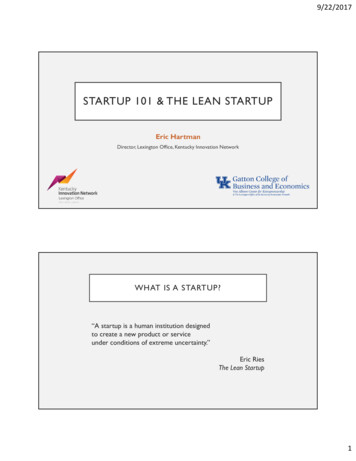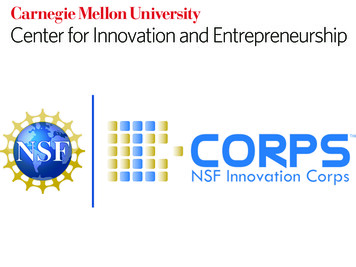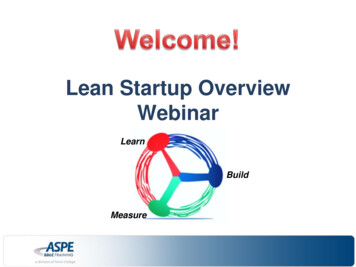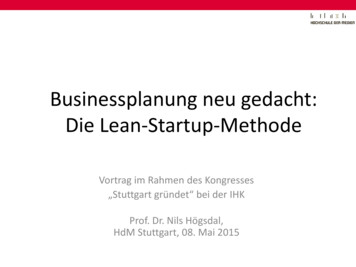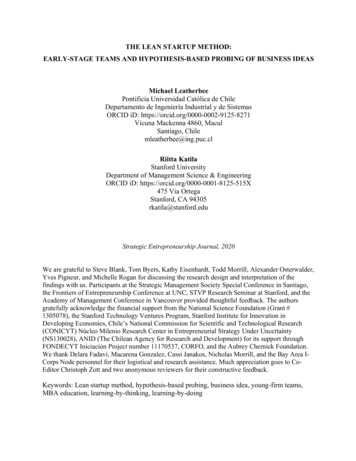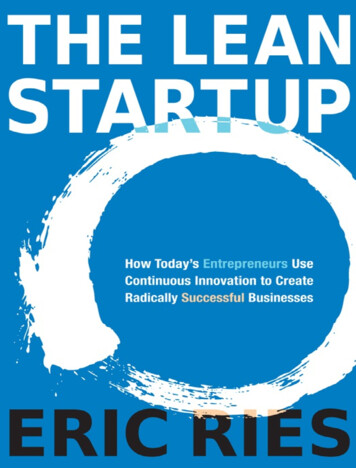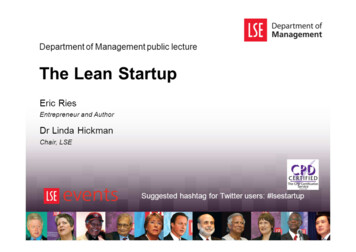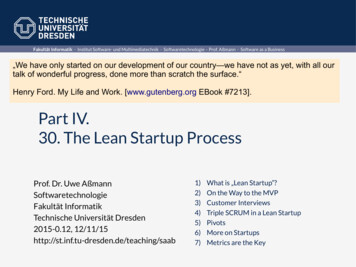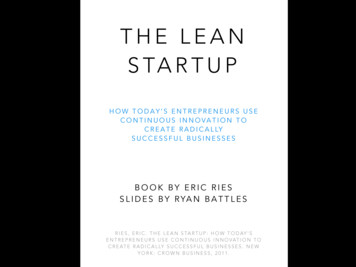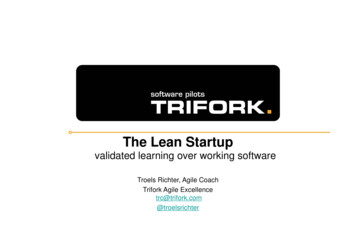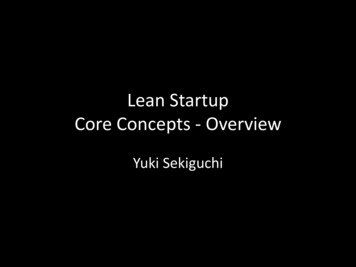
Transcription
Lean StartupCore Concepts - OverviewYuki Sekiguchi
The goal of a startup is to figure outthe right thing to build – the thingcustomer want and will pay for – asquickly as possible.If you make something nobody want, it does not matter whether youmake it on time or on budget.The difficulty of a startup comes from its inherent uncertainty. Youdon’t know who your user/customers are and what value you shouldoffer them.Lean Startup is a methodology that helps startups to move to theright direction quickly by systematic experiments.
ProductStrategyVisionThe inherent uncertainly doesn’t mean that you should “just do it” orgo along with whatever potential customers say.The destination as well as a starting point is a startup’s own vision.To achieve that vision, startups employ a strategy, which includes abusiness model, a product roadmap, a point of view about partnersand competitors, and ideas about who the customers will be.The product is the end result of this strategy.
ts change constantly through the process of optimization(tuning the engine).Less frequently, the strategy may have to change. That event is calleda pivot.The overarching vision rarely changes.
The core process in achieving the visionis Validated Learning.In the Lean Startup model, every product, every feature,every marketing campaign – everything a startup does –is understood to be an experiment designed to achievevalidated learning. The effort that is not absolutelynecessary for learning is waste and should be eliminated.“Learning” is often used as an excuse for a failure of execution orafter-the-fact rationalization. To draw a clear distinction, LeanStartup uses the word “Validated”.“Validated Learning” is the process of demonstrating empirically thata team has discovered valuable truths about a startup’s present andfuture business prospects.
Have a clear hypothesis- Value hypothesistests whether a product or service really delivers to customers oncethey are using it.- Growth hypothesistests how new customers will discover a product or service.To experiment and gain validated learning, you need to have a clearhypothesis that makes predictions about what is supposed to happen,to test against.Startup experimentation is guided by the startup’s vision, as the goalis to discover how to build a sustainable business around that vision.The two most important assumptions, the riskiest elements and onwhich everything depends, are the value hypothesis and the growthhypothesis.
Step one is to have a strong vision. You must then test thatBuild - Measure - Learn Feedback LoopMinimize total time through the loopThe core process of Lean Startup. It may look similar to othermanagement methods like PDCA, but this loop is based on moreconcrete and empirical steps. The biggest difference is its focus onminimizing total time through the loop.
MVP (Minimum Viable Product)A technique to start the learning process asquickly as possible. The fastest way to getthrough the loop with minimum amount of effort.Complexity varies depending on the hypothesisand requires judgment.Unlike a prototype or concept test, an MVP is designed not just toanswer product design or technical questions. Its goal is to testfundamental business hypothesis.Any additional work beyond what was required to start learning iswaste. Will cover more details in subsequent sets of slide in the future!
Innovation AccountingThree Learning Milestones1. Establish real data on where the company is right now (usinga MVP)2. Tuning the engine - Devise experiments to learn how to movethe real numbers closer to the ideal reflected in the plan(may take many attempts)3. See if the company is making good progress toward the ideal pivot or persevereIt applies to the Measure and Learn phases in the loop. A quantitative approach tosee whether a startup’s efforts are bearing fruit. Learning milestones are analternative to traditional business and product milestones.After the startup has made all the micro changes and product optimization it can tomove its baseline toward the ideal, the company reaches a decision point. Was thehypothesis correct? What changes necessary to the current strategy?
Pivot (or Persevere)- The most difficult question any entrepreneur faces, uponcompleting the Build-Measure-Lean loop- Change of strategy based on validate learning – a specialkind of change designed to test a new fundamentalhypothesis about the product, business model, and engineof growth- Requires human judgment and come in different formsA pivot requires that we keep one foot rooted in what we’ve learned so far,while making a fundamental change in strategy. Not a simple 180 change.It may be wise to schedule “pivot or persevere” meeting in advance. Eventhough you know that’s coming, it doesn’t mean that it is emotionally easy. Will cover more details in subsequent sets of slide in the future!
Lean Startup is a methodology that helps startups to move to the right direction quickly by systematic experiments. The inherent uncertainly doesn’t mean that you should “just
